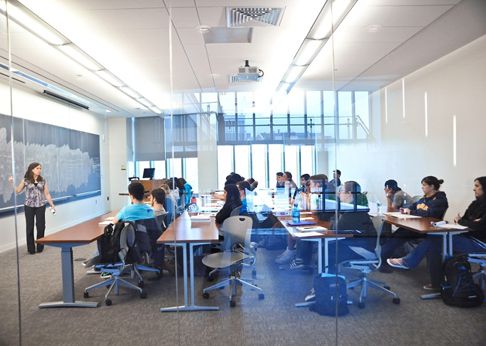Loyola Science Center Meets Gold Standard for Sustainability

From the standpoint of Leadership in Energy and Environmental Design, or LEED, all that glitters is not gold. The gold standard is reserved for significantly “green” projects that meet or exceed requirements for the second-highest certification level on the U.S. Green Building Council’s four-level scale.
The University of Scranton’s 200,000-square-foot Loyola Science Center earned LEED gold status.
LEED certification is globally recognized as the premier mark of achievement in green building, a concept to which the University has long been committed, said Mark Murphy, the University’s director of sustainability. The University’s 118,000-square-foot Patrick and Margaret DeNaples Center achieved silver-level LEED recognition in 2009, becoming the city of Scranton’s first-ever LEED certified building.
Materials used, water efficiency, innovative energy strategies and indoor environmental quality were among the key factors considered for the Loyola Science Center’s gold certification. The building also received special recognition for having a green-housekeeping standard, Murphy said, noting that more than 95 percent of cleaning supplies used in the building now have a green seal of approval.
Among the science center’s many “green features” are energy-efficient lighting and controls, water conserving plumbing fixtures, high efficiency boilers and chillers, rain garden features, green house, observation deck and a computerized building control system that operates the ventilation, heating, and air conditioning systems.
Materials for the center were supplied from within a 500-mile radius, including a blend of locally quarried West Mountain stone.
Energy saving was a high priority and all laboratories and spaces have been designed to maximize energy efficiency. The building’s massive heating, ventilation and air-conditioning system employs a heat-exchange wheel to recirculate already conditioned heated or cooled air.
The center also was recognized for having a LEED accredited professional on the project-development team and for niceties such as bicycle storage.
The Loyola Science Center’s design builds on the concepts of Project Kaleidoscope, the leading advocate for enhancing the quality and effectiveness of science teaching and learning. The building, designed by Einhorn Yaffee Prescott Architecture & Engineering (EYP), is most visually recognizable for its extensive use of glass that admits natural light into laboratories and teaching spaces. The design makes extensive use of high-efficiency glazing to reduce energy consumption, enhance visibility and views and puts science on grand display. Equations are regularly visible on the glass classroom walls, not only for students and faculty but for passers-by as well.
George Gomez, Ph.D., associate professor of biology and neuroscience and project shepherd, referred to the new facility as “a drastic change in environment … It is a structure that redefines the concept of a learning space.”
The center’s layout provides a physical space that encourages integration among the traditional STEM, or science, technology, engineering and mathematics programs, as well as the humanities.
The facility was intended to dazzle with a dynamic and modern appearance, but sustainability also is “an issue of justice,” said Murphy, of making resources available not only to current users but to future generations. What it comes down to is education and “caring for creation.” “These LEED buildings are our example to the local community and to our students,” Murphy said.
The $85 million center, dedicated in the fall of 2012 and the culmination of more than 15 years of planning and preparation, is the largest capital project in University history.






